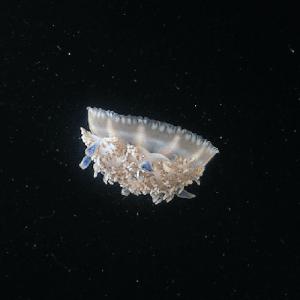

rely on the symbionts as a developmental trigger ( Hofmann et al., 1978 Colley and Trench, 1985). Similar to their coral relatives, nutrient exchange is a key component supporting this cnidarian-dinoflagellate mutualism ( Hofmann and Kremer, 1981 Welsh et al., 2009 Freeman et al., 2016). High light penetrance is important for species within this genus, as the jellyfish hosts one or more photosynthetic dinoflagellate species of the genus Symbiodinium ( Hofmann et al., 1996 Lampert, 2016).

are unique among scyphomedusae in that their characteristic flat exumbrella rests on the sea bottom, while their convex subumbrella and oral arms face upwards. The upside-down jellyfish Cassiopea is a benthic scyphozoan (Rhizostomeae) commonly found in tropical and sub-tropical shallow coastal ecosystems, such as mangroves and seagrass beds. This review provides an overview of the broad range of interdisciplinary research that has utilized the Cassiopea model and highlights the advantages of using the model for future research.

With these developments, resources including genomes, transcriptomes, and laboratory protocols are steadily increasing. Recently, the Cassiopea research system has gained interest beyond symbiosis in fields related to embryology, climate ecology, behavior, and more. Cassiopea is also unique in requiring the symbiont in order to complete its transition to the adult stage, thereby providing an excellent model to understand symbiosis-driven development and evolution. As an easily culturable and tractable cnidarian model, it is an attractive alternative to stony corals to understanding the mechanisms driving establishment and maintenance of symbiosis. The upside-down jellyfish Cassiopea xamachana (Scyphozoa: Rhizostomeae) has been predominantly studied to understand its interaction with the endosymbiotic dinoflagellate algae Symbiodinium. 22Smithsonian Tropical Research Institute, Smithsonian Institution, Washington, DC, United States.21Odum School of Ecology, University of Georgia, Athens, GA, United States.National Oceanic & Atmospheric Administration, National Ocean Service, National Centers for Coastal Ocean Science, Charleston, SC, United States 19Department of Botany, University of British Columbia Vancouver, Vancouver, BC, Canada.18TropWATER and College of Marine & Environmental Sciences, James Cook University, Townsville, QLD, Australia.



 0 kommentar(er)
0 kommentar(er)
